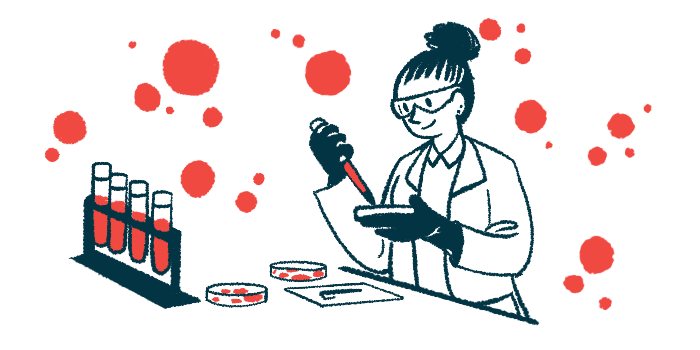Specialized lab technique helps ID early drivers of lung scarring in PF
Findings show cellular changes promote fibrosis, may lead to new treatments

Using a specialized lab technique, a collaborative U.S. research team identified cellular changes in the body that could be early drivers of lung scarring (fibrosis) in people with pulmonary fibrosis (PF).
That’s according to the findings of a new study in which the researchers, from three universities, exposed lung tissue to blue light. The scientists say their findings could lead to a better understanding of lung fibrosis at the disease’s earliest stages.
In live lung tissue samples, the team found that stiffening of the protein network surrounding cells — known as the extracellular matrix, or ECM — led to changes in key lung cell populations that further promoted scarring.
Moving forward, their experimental approach can be used to better understand the early drivers of fibrosis and to develop new PF treatments, the researchers say.
“We’re not trying to recreate fibrosis in the lab. … We’re identifying its starting point,” Claudia Loebel, MD, PhD, assistant professor at the University of Pennsylvania and the study’s senior author, said in a university press release. “If we can understand the first responders [in this process], we can work toward treatments that prevent [it] from happening.”
The study, “Local photocrosslinking of native tissue matrix regulates lung epithelial cell mechanosensing and function,” was published in the journal Nature Materials. The research team comprised scientists from the University of Pennsylvania, the University of Michigan, and Drexel University in Philadelphia.
PF is characterized by inflammation and fibrosis in the lungs that typically worsens over time. Scarred lung tissue is stiff and rigid, impairing usual lung function.
Symptoms such as shortness of breath and cough can eventually give way to serious complications, including impaired oxygen delivery or respiratory failure.
Investigating lung scarring in PF at its early stages
Approved therapies can help slow the progression of lung fibrosis, but “they don’t stop it or reverse it,” according to Loebel. “What’s worse is that we often don’t know what caused it in the first place, so we also don’t have a clear idea of how to prevent it,” Loebel added.
Much research in PF is focused on later disease stages, when substantial fibrosis has already set in. At that point, notable alterations are seen in the ECM — the protein network surrounding cells that supports their structure and function.
Less is known about the early changes that promote lung scarring and the role of the ECM in that process.
Now, the team of scientists aimed to examine whether early ECM stiffening — which could be caused in a real-life setting by injury or damage — changes cellular behavior in ways that contribute to uncontrolled fibrosis.
To mimic that early tissue stiffening in a lab setting, the scientists exposed live mouse and human lung tissue to visible blue light, a technique called photochemical cross-linking.
“Think of the extracellular matrix like loose hair in a ponytail,” explained Donia Ahmed, a doctoral student in Loebel’s lab and the study’s first author. “With light-triggered cross-linking, we braid it, stiffening the tissue just enough to mimic the kind of micro-injuries that might trigger fibrosis.”
Normally, alveolar type 2 epithelial cells, which help protect and repair lung tissue, serve as precursors to alveolar type 1 epithelial cells, which are responsible for gas exchange in the lungs.
When the lung tissue stiffened, the scientists observed that this transformation began to occur, but stopped mid-transition.
“These cells were caught in a sort of identity crisis,” according to Ahmed. “They were stuck between types, unable to perform either role well.”
Are ‘stuck’ cells key to fibrosis progression? Scientists think so.
The scientists believe that these semi-transitioned cells are key to the progression of fibrosis.
Stuck in an in-between state, the cells actively contribute to the accumulation of ECM proteins and tissue stiffness that initially prompted their development.
This creates a feedback loop in which the tissue becomes increasingly rigid, impairing the structure and function of the cells typically found there — and possibly recruiting other, more damaging cell types better able to thrive in that environment.
While these epithelial cells appear central to the fibrotic process, the researchers now plan to use their new technique to further study the role of various other cell types.
Given the lack of diagnostic tools for early stage lung fibrosis, this model may further be useful [toward] the development of diagnostic tools and therapeutic approaches.
According to Loebel, “this is just the first step” in understanding what drives such scarring.
“Now that we’ve built this tool, we can use it to look at cell-specific contributions to fibrosis, not just in the lungs, but potentially in other organs,” Loebel said.
The researchers hope future findings will better equip scientists to predict who is at risk for PF, and to develop better ways to treat the disease.
The researchers concluded that, “given the lack of diagnostic tools for early stage lung fibrosis, this model may further be useful [toward] the development of diagnostic tools and therapeutic approaches.”









